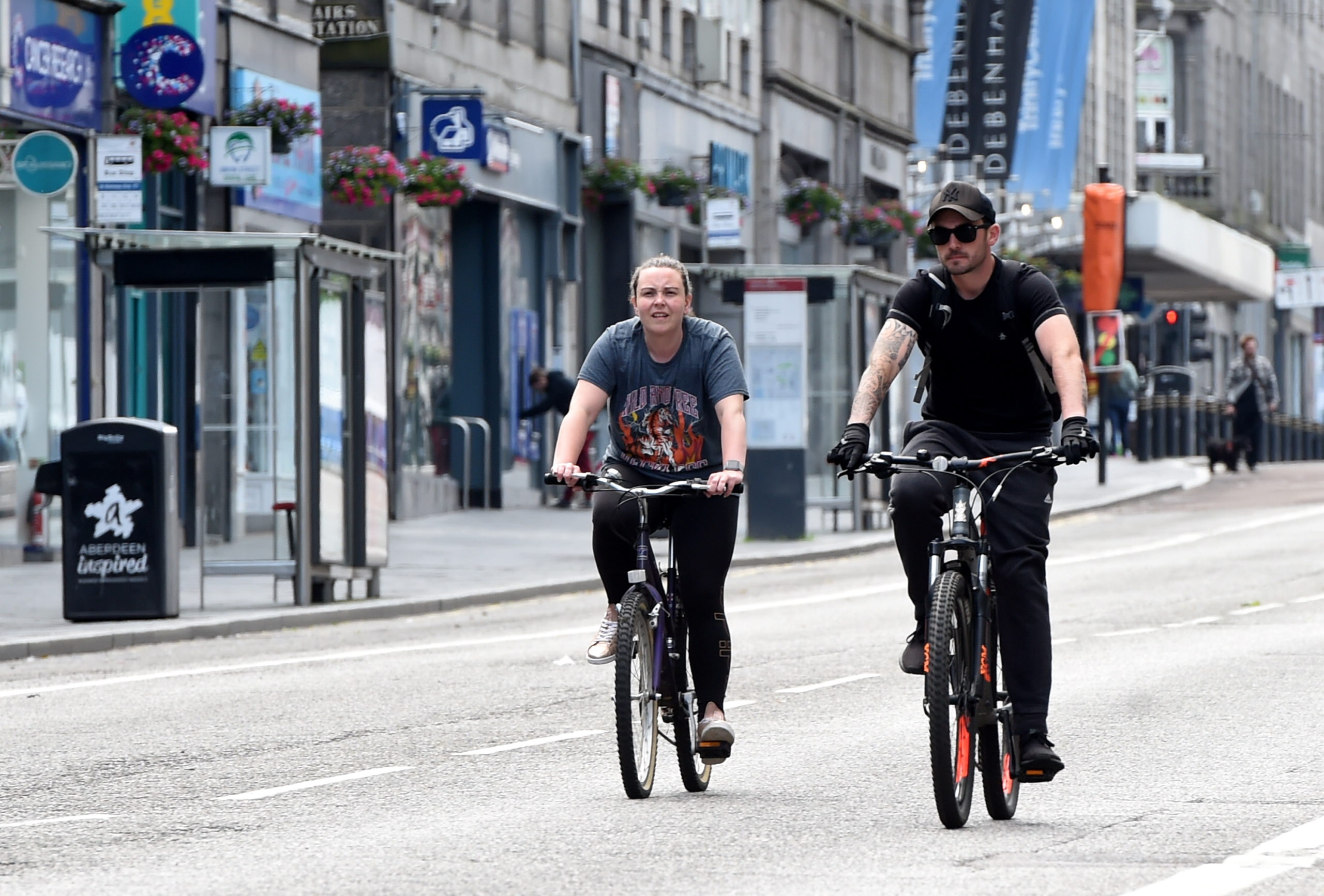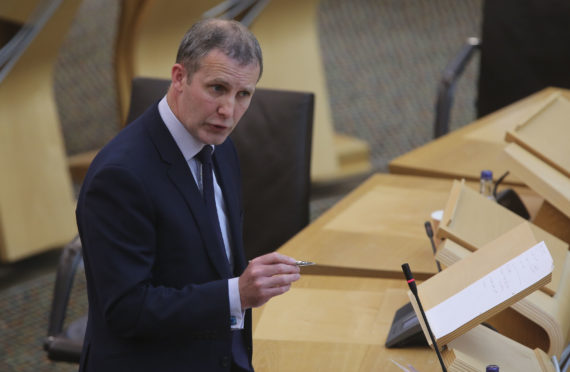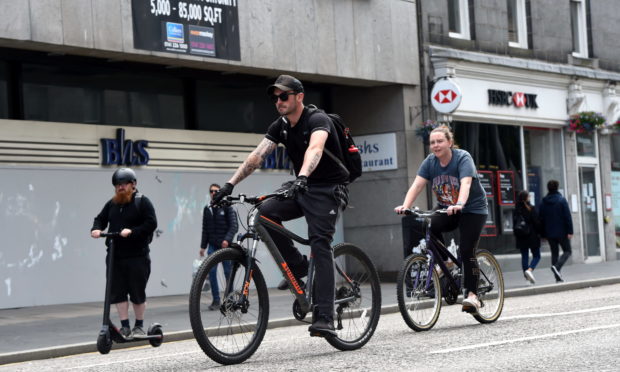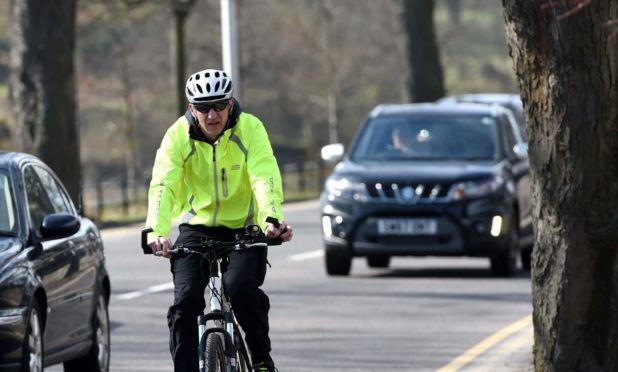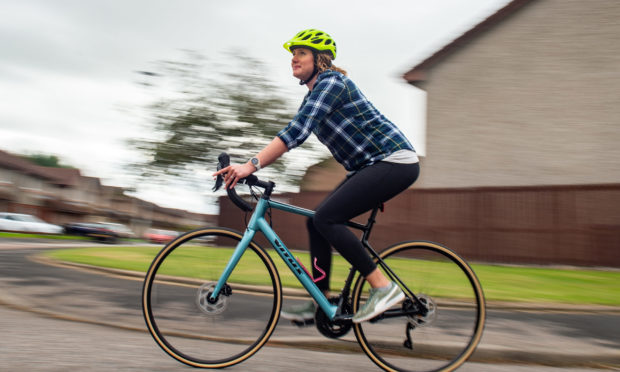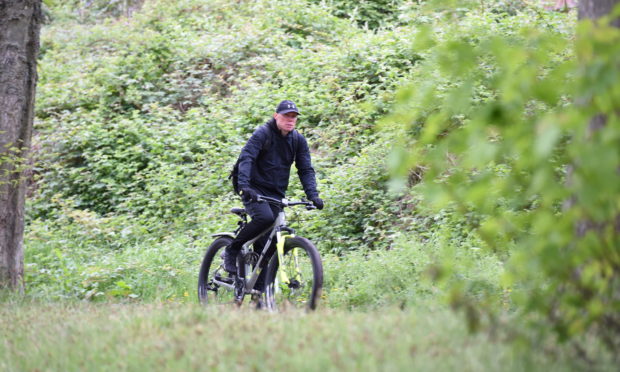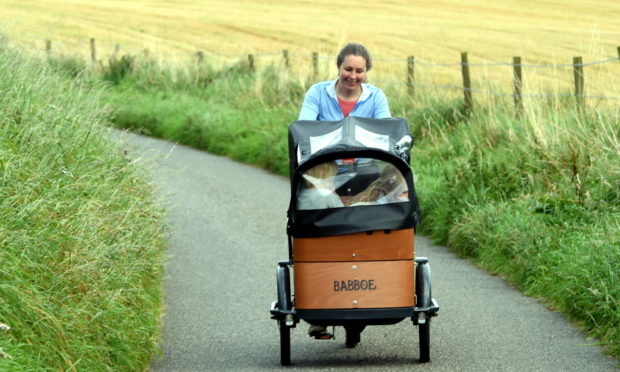Cycling has enjoyed a surge in popularity during lockdown, with novices encouraged out in their droves thanks to roads emptied of home workers. In the first of a new series, the Press and Journal speaks to campaigners who say councils need to commit to preserving cycle-friendly infrastructure post-pandemic.
Councils across Scotland cannot allow traffic to return to pre-Covid levels as lockdown restrictions continue to ease later this year, environmental and cycling campaigners say.
Across the country, roads emptied by the coronavirus pandemic have been reclaimed by pedestrians and cyclists, the lack of cars giving them the confidence to take to the roads.
Around 1.3 million bicycles are thought to have been purchased in the first three months of lockdown, according to data analytics firm GlobalData.
A £30 million pot of cash was set aside by transport bosses to encourage good transport habits, which has been seized by local authorities.
Aberdeen City has sought almost £2 million from the pot to create cycle lanes and widened pavements across the area, while Aberdeenshire, Highland and the island councils have successfully applied for cash to do the same in local communities.
The Spaces for People fund, administered by Sustrans on behalf of Transport Scotland, has helped to amplify the benefits associated with lower car use and an uptick in active travel.
Shopkeepers in Aberdeen say they are enjoying surprisingly high levels of business in areas where active travel measures have been improved, including on Union Street, which has been partially pedestrianised.
Air quality has also improved on typically gridlocked thoroughfares. Daily average nitrogen dioxide levels on Union Street have fallen from a January peak of 74.8 microgrammes per cubic metre of air (mgcm-3) to a low of 3.6 at the end of May – less than a tenth of the daily safety limit of 40mgcm-3.
Gavin Thomson, air quality campaigner with Friends of the Earth Scotland, says the pandemic has presented councils and governments with a rare opportunity to think hard about the future they want.
“It’s time to think about the healthy and sustainable changes we can make to where we live,” he said.
Some councils have sought more Spaces for People funding per head than others for Spaces for People funding, creating unequal travel networks.
Aberdeen City, for instance, has sought almost seven times more funding per head than Aberdeenshire for active travel projects.
Mr Thomson says such projects cannot wait any longer to be implemented – and must be made to happen before the pandemic is over.
“We don’t have time to wait, from a public protection or a carbon emissions point of view. We know cycle lanes work all over the world. We can’t wait any longer.
“We probably have the 2020s to change the way we travel in order to meet our climate targets.
“What will the school run look like, for instance? Have councils erected pop-up cycle lanes? Families cycling to school, knowing it would be same for them to do so, would be great.”
Campaigners fear moves to encourage cycling will not continue once the pandemic is over – and are imploring councils to make some of the changes they are trying out permanent to protect public health.
Rachel Martin, of Aberdeen Cycle Forum, says Aberdeen City Council has been fixated on “moving traffic, rather than removing it” for too long.
“We want the council to build cycling infrastructure so people who don’t cycle take it up,” she says.
“There is a place for the car – but the city centre is not that place.”
Twice as many bicycles have been recorded on Aberdeen’s streets in the first four months of 2020 than at the same time in 2018 and 2019 combined – and more recent figures for July suggest the trend is not slowing down.
However, car use compared to before lockdown restrictions were eased has more than doubled, and campaigners such as Rachel hope public authorities reassess their transport priorities to enshrine good, healthy transport habits in the public consciousness for good.
Caroline Hood, a cycling policy expert at Robert Gordon University and vice-chair of the Grampian Cycle Partnership, says councils need to work to make cycling accessible and less intimidating – and that means cycle lanes.
“If you create walking and cyclable environments you’re making cities and towns a nicer place for everybody. This isn’t about the Mamils,” she says, referring to the ‘middle-aged men in Lycra’ who, for some, personify the problematic aspects of cycling.
“It’s about families riding with kids and removing the barriers to getting on a bike.”
While cycling is feasible and accessible in the countryside, problems exist in more urban landscapes, where cars have been prioritised for decades.
Unlike in other European cities such as Utrecht, Copenhagen and Amsterdam, active travel has been sidelined for years in the likes of Aberdeen, with infrastructure built to encourage an ever-rising number of cars to pass through and around our cities.
Such measures only serve to discourage bicycle use among less confident bike riders, reducing air quality and contributing to worsening public health.
For instance, as Ms Martin points out, while children are allowed to cycle on pavements, adults aren’t – putting the kibosh on any city centre family cycling trips.
Just one in five people across Aberdeen and Aberdeenshire don’t have access to a car, and on a typical day in 2018, cars alone outnumbered bicycles by a factor of 192 to one.
Cyclists also remain unsafe, accounting for 10.9% of all casualties on the roads despite being used for less than 2% of all trips, according to Cycling UK.
The Department for Transport also says cyclists are 42 times more likely to be killed or seriously injured on the roads than car drivers.
Over the course of the coming days, the Press and Journal will speak to cyclists, campaigners, local councils and the Cabinet Secretary for Transport in a bid to understand what they see as the future of transport in the north of Scotland and across the country as a whole.
To the likes of Ms Martin, Mr Thomson and Ms Hood, the time is now to make the roads safer, cleaner, and better for all.
“Using the road network is a privilege,” Ms Hood adds.
“We used to be able to hop in our car – anything that stops us from being able to enjoy that practice is regarded with suspicion and discomfort.
“There’s a much bigger conversation to be had about road safety, and we need to spend a lot more time thinking about a person-centred approach to transportation.”
Share your views on cycling where you live
The Press and Journal is looking for cyclists from across the north and north-east Scotland to complete our Pandemic Pedal Power survey, sharing views on how your cycling habits have changed – or even formed – during lockdown.
The survey is open to both experienced and novice cyclists, and completed surveys will be entered into a draw to win a £50 Halfords voucher.
If you have anything further you’d like to contribute to our story, email jbrady@dctmedia.co.uk with pictures, videos and anything else you’d be happy to share.
